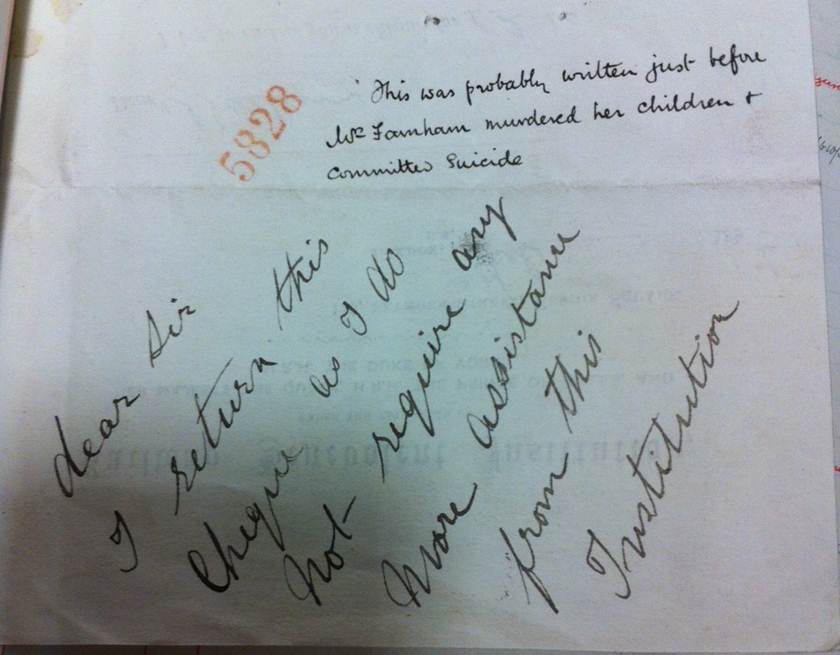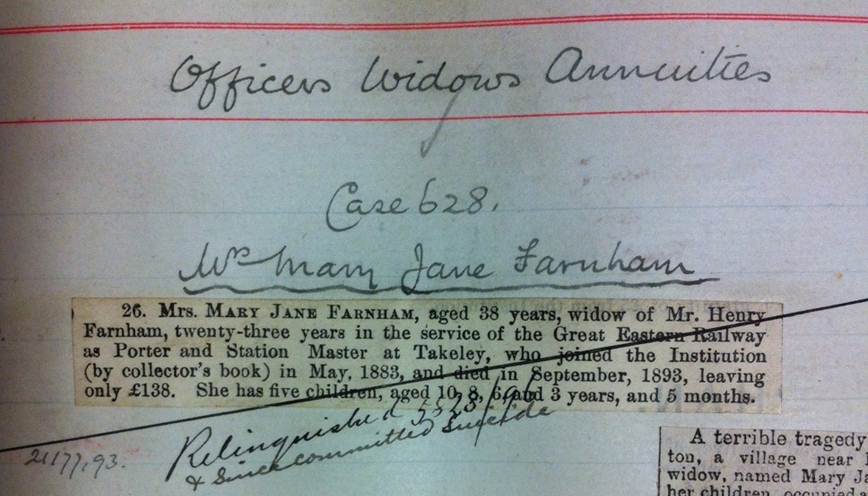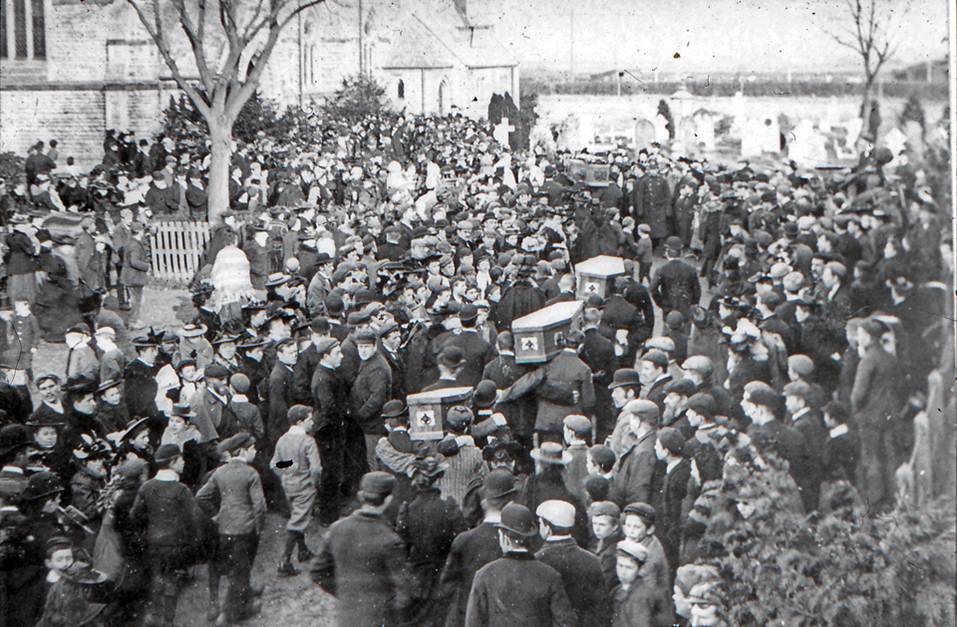The note said: ‘This was probably written just before Mrs Farnham murdered her children and committed suicide.’
Underneath this, in Mrs Farnham’s handwriting, it said: ‘Dear Sir, I return this cheque as I do not require any more assistance from this Institution.’
I challenge anyone finding a note like this to simply close the book and go to lunch. I wanted to know more.

Mrs Farnham’s note (catalogue reference: RAIL 1166/81)
The note was tucked into a volume of payments made by the Railway Benevolent Institution (RBI) to widows and orphans of railway men killed or injured on the railway, held here at The National Archives under reference RAIL 1166. The RBI was founded by a group of railway clerks in May 1858, and still continues today under the name The Railway Benevolent Fund.
So why was Mrs Farnham receiving payments from the RBI, and why did she commit such a terrible crime?
The RBI volume included an entry for her, stating that her husband, Henry Farnham had been a porter and station master at Takeley Station, Bishops Stortford, on the Great Eastern Railway. He had died in 1893, leaving his wife, Mary Jane, with five children to support.

Railway Benevolent Institution ledger (catalogue reference: RAIL 1166/81)
According to the census, birth and marriage records, Henry Farnham was born in Audley End in 1852. His future wife Mary Jane Peacock was born at Upwell, Cambridgeshire, in 1855.
In 1871 Henry was a Railway Porter at Stonea Station in the parish of Wimblington, close to where Mary Jane grew up, and they married in North Witchford , Cambridgeshire, in 1877. By 1881 Henry had become Station Master at Takeley, where he remained until he died. He was buried in Takeley churchyard on 10 September 1893, aged 41. Their five children were all baptised at Takeley Church.
Also included in the RBI volume was a press cutting from the Daily Telegraph dated 20 February 1896, which described how the police had broken into Mrs Farnham’s cottage only to find her body and those of four of her children.
This was not a spur-of-the-moment attack. Mrs Farnham had planned the murder of her children and her own suicide. She had made sure that her debts were paid. The police found £3 10 shillings in a sealed envelope, labelled ‘Mrs Fishers Rent’. And on the previous Saturday night her eldest daughter had been sent to the baker’s shop to pay for two loaves of bread, although it had always been Mrs Farnham’s routine to pay on Wednesdays when the baker’s cart came round. Her neighbours reported that Mary Farnham had become very distressed at times, and she had often commented on the fact she had been left with five young children.
Henry Farnham had died two years earlier after a prolonged illness of acute congestion of the lungs. He was much liked and respected, and friends and neighbours collected £70 for the family when he died. Mrs Farnham had found it very difficult to cope without him, although she was not hard up financially.
At the inquest the jury returned a verdict that Mrs Farnham murdered her four children and committed suicide while temporarily insane.
The funeral took place at Wimblington churchyard, and I would like to thank The Fisher Parkinson Trust for permission to use their photograph of the funeral below. The family were interred in a double grave: Mrs Farnham was laid by the side of the two younger girls, and the bodies of the boy and the second girl were placed above.
Thousands of people from March and the surrounding district attended the funeral, including the family’s eldest daughter and sole survivor, Lucilla, who was away in service at the time of the tragedy; the greatest compassion was felt for her. She was heartbroken, but placed emblems composed of snowdrops on each coffin as it was lowered into the grave.

Farnham family funeral. 1896 (with the kind permission of the Fisher Parkinson Trust.)
Further census searching shows that Lucilla was taken in by her aunt and uncle, and by 1901 she was working as a Draper’s Assistant in Leeds. She married a Mr Daniel Meany, in Exeter, in 1917, when she was 34 years old. She went on to have a child of her own.
This has not been a happy story and I did not set out to find it, but I wanted to show how just one small slip of paper can be the key to unlocking vivid stories in the records held at the National Archives and elsewhere. This was a true story, involving a real family 120 years ago, pieced together from a variety of sources. And the key was found by chance in an unassuming volume of railway-related payments.
Who knows what you will find when you start searching.

An amazing find of a very sad story of an incident that continues to happen today although it more often divorce rather than death that is the cause of a family split
An amazing and heartbreaking story. It’s fantastic what can actually be found out from a slip of paper.
My husband knows nothing of his grandfather’s origins or family, apart from his 20/5/1907 Dorsetshire Regt. attestation papers in which he states his family is in New York. Arthur George Shaw had a son named Donovan, and thinking such an unusual name might be a family name I came across the story of Norah (nee Shaw) who had a brother Donovan Shaw. Norah’s story came to a sad end during WW1, when she and her husband died in a murder-suicide. Probate was given to her husband’s father, and then rescinded and assigned each to their own father. Interestingly Norah’s father was listed as in USA by that time. I’m grateful for the ability to search these things, but .. I still don’t know if there is a link to our family.
My maiden name was mason
I have two copies of this very sad and tragic event in original cambs times .One is the week in which the poor unfortunate beat bobby discovered Mary Jane and her children and the following week is of the funeral. Even today it still makes very sad reading. Both news papers were in my grandfathers possession when he died years ago although why has always been a mystery.
Fascinating find. Came across this researching family history. I also discovered that the £70, collected on Henry Farnham’s, death was contributed to by the Prince of Wales (Future Edward VII) because he used to use Takely station regularly. Further, he had an ‘amusing incident’ with Henry Farnham who did not recognise him and tried to enforce ticketing rules. Reported here: https://trove.nla.gov.au/newspaper/article/19028168/169544#
Most of us that grew up in the village knew that she had killed herself and her children but the why had disappeared from village gossip. It’s good that her story has in part been told and that her and her children have not and will not be forgotten.
I’ve just discovered my Peacock ancestry and the 1911 census shows that Arthur Peacock was living at Addison House with his 6 children, none of whom bear the name of this poor lady. I’m sure she must be related to the Wimblington Peacock’s! Ironically my late adoptive father was a railway worker and my 83 year old mother still receives a Bristish Rail pension. Whilst there is clearly a huge tragedy surrounding this story I appreciate the information that has been provided in my quest for ancestral knowledge!
The 13 year old girl who was left behind was my father’s mother. Lucy.